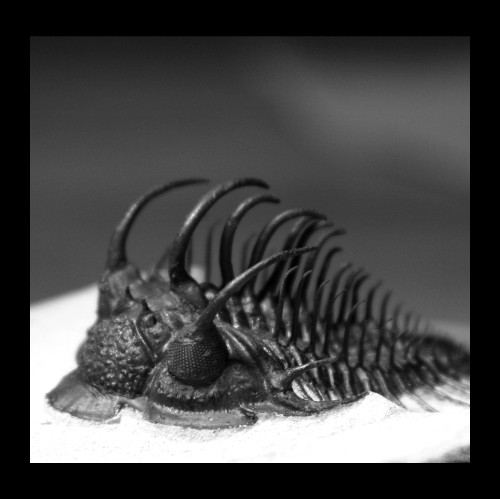
Website launch date: 05 / 15 / 2003.
Last update - April, the 27th of 2007.

|
|
|
|
|
|
Welcome on "trilobite-identification.com". The following pages try to show to amateur palaeontologists an other way of looking at their trilobites and to better understand both their diversity and their specificity. The systematic is that part of the zoology that classifies the living beings; this is via the reading of long pages of the systematic books that you can affirm thay neither you nor your neighbour are baltic herings.
This site was basically made to share both a personnal collection and a decent scitentific library dedicated to trilobites, but it slowly turned into an attempt to show the importance to have a very close look at its own trilobite with an "opened eye" in order to completely re-discover them. It is striking to constat that most of the specimens of private collections are misidentified, with the exception of the worlwide famous american Elrathia kingi, a small Ptychopariid - but even that species has its trick as authors indistinctly refer to it as Elrathia kingii or E. kingi :)
Why is it so difficult to correctly ID a trilobite ? The next time you go to a sea-food restaurant, try to identify the 10 crustaceans you have in your plate (I can't myself btw) :) Now, imagine you will have to ID crabs that are 300 millions years old, amongst 15 000 species, not to mention the sub-species.
This is why, with the help of pictures, plates and textbook references this site is especially meant to help in the identification of trilobites collected or (more often) bought and whose descriptive label might be lost, incorrect, fraudulent, or insufficient, sometimes non-existent (I'm thinking in particular of the Moroccan trilobites). There are three ways "of entering" my data base :
| Photographic Atlas |
| Alphabetical listing |
| Taxonomic position |
| Links |
| References |
| Glossary (in french) |
| Diagnoses listing |
| Wanted |
In practice, I will especially try to provide the points which clearly make it possible "to establish a systematic diagnosis" for your trilobite. If the final result is not what you were expecting, do not hesitate to send me a question, or better still, pose your question to this remarkable forum : Yahoo trilobite club (frequently refered here as YT2G)
Ah yes, while I'm thinking of it : this site's role is not to point out basic "trilobitology." Many others do that a thousand times better than I might. You can for this purpose consult the remarkable site of Sam Gon III: A Guide to the Orders of Trilobites.
Last but not least, a short outline about something else besides a trilobite ;)
Thanks : to Patrice Lebrun, for his remarkable work of synthesis on the trilobitic fauna of France, and his authorization to use its remarkable Except Series to base a significant share of the diagnoses of the French trilobites presented on this site.
To Pierre Morzadec for the width and the quality of his work, which gave me the desire for making "more" than a simple collection of trilobites.
To Sam Gon III, for his advice, his help, his superb site and his incredible patience ;)
Special thanks to all US / world sellers and / or friends that allowed me to use a few pictures of some of their great bugs ! :)
Chief-translator : Sam Gon ;) Thx again, Sam ! :)